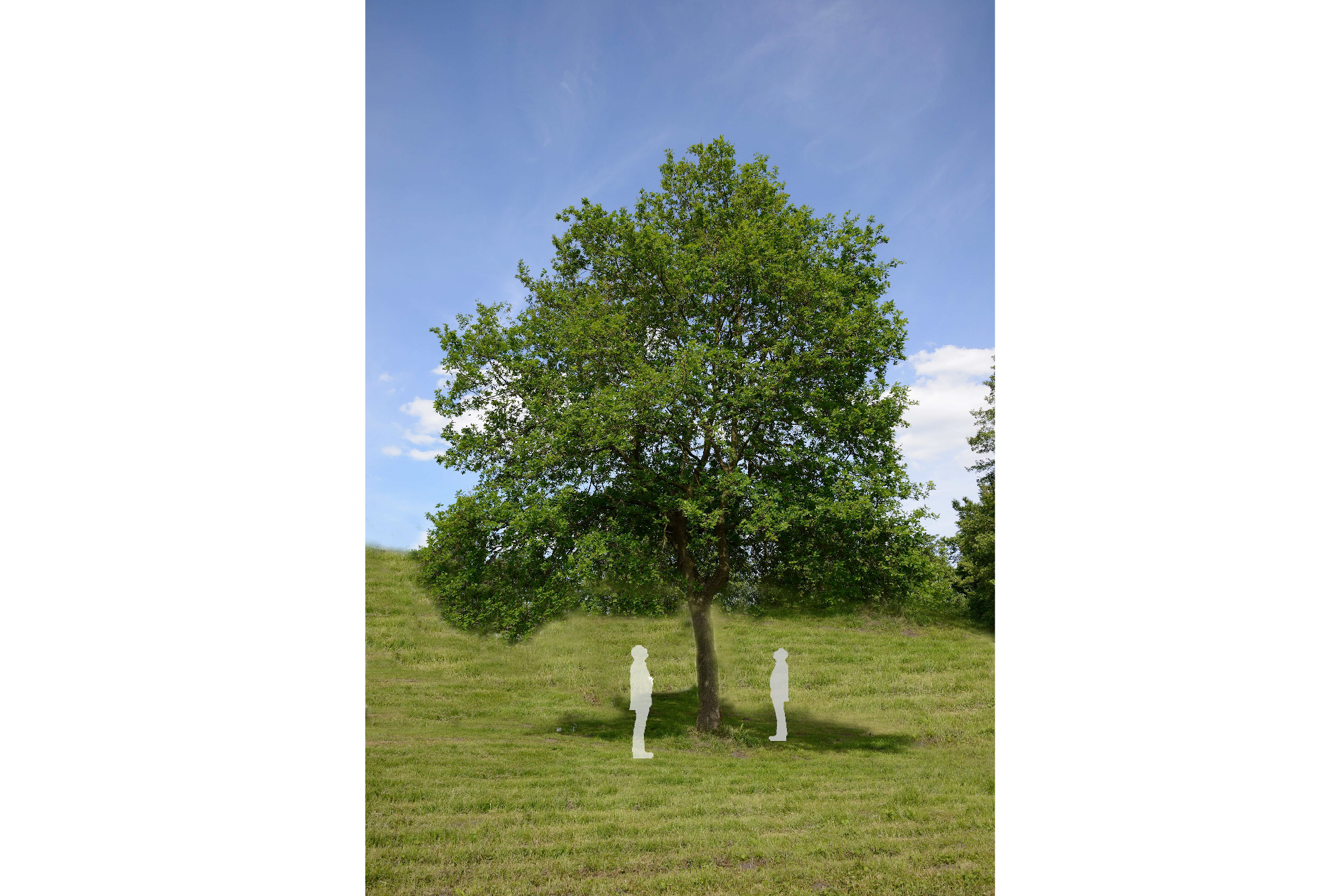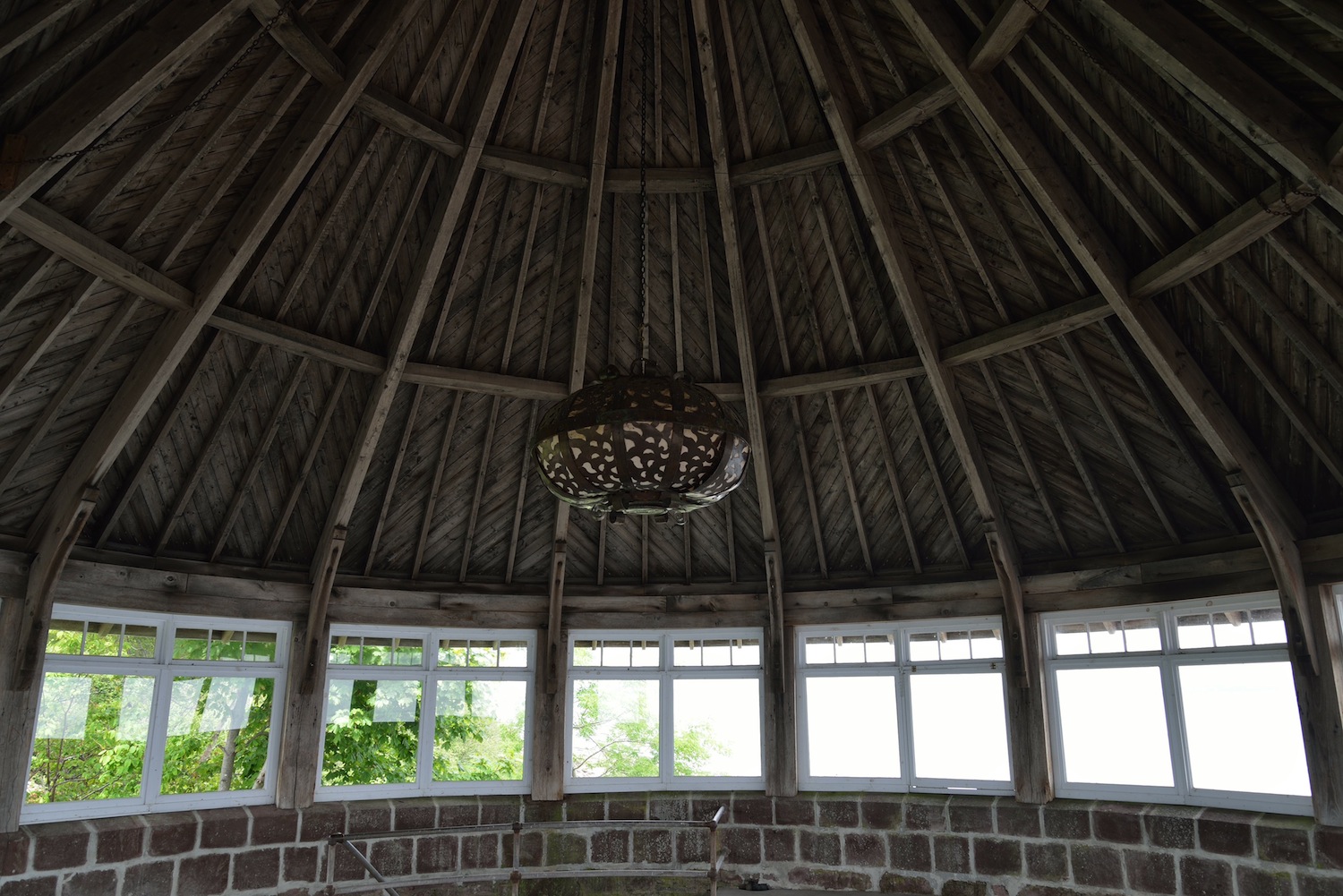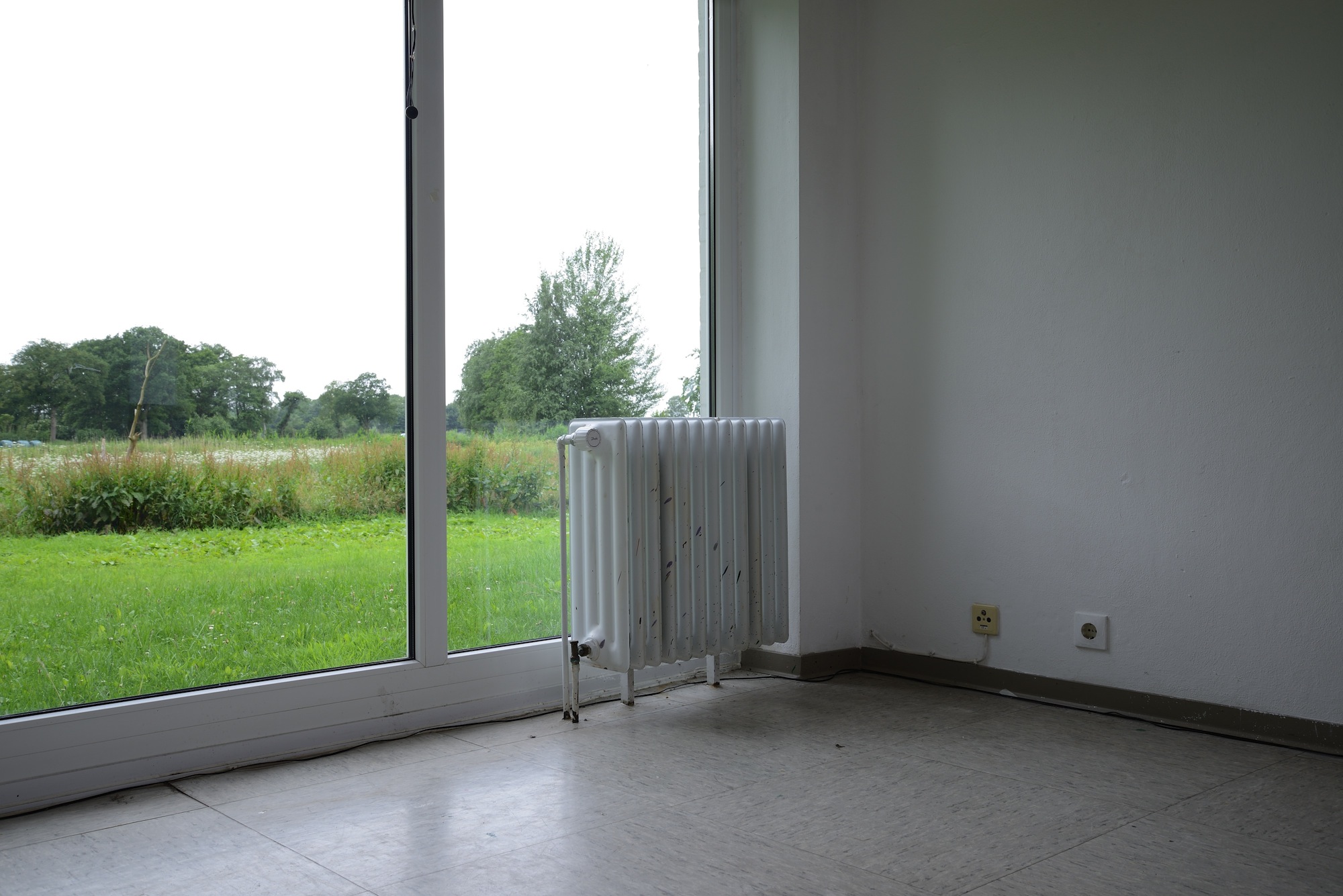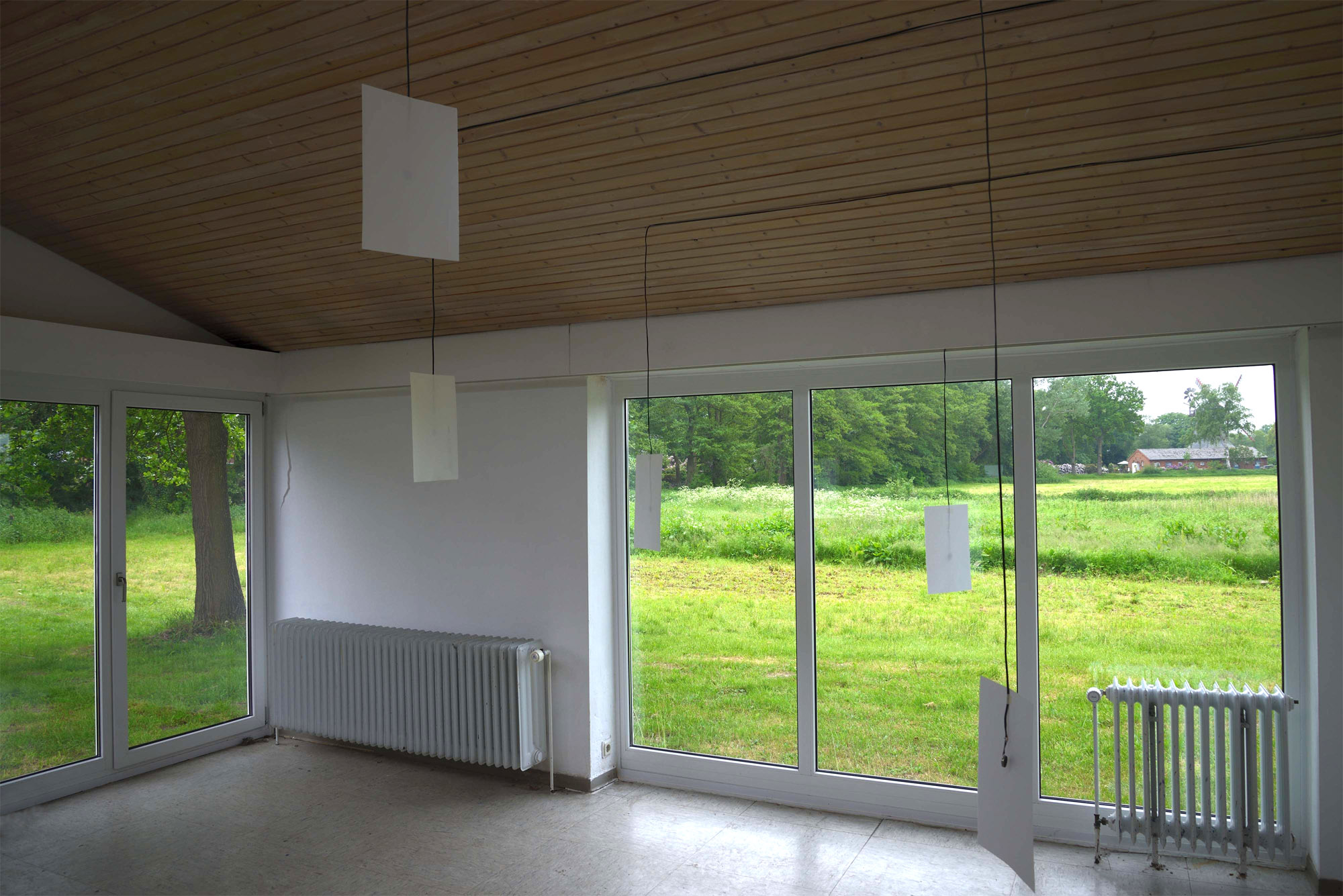VOICE LANDSCAPE PROJECTS
Conception
VOICE LANDSCAPE PROJECTS (2009- ) is the sound installation series in which recorded voice of the artist such as onomatopoeia and lip noises are electrically transformed into presence of insect and natural phenomenon on computer in concord with natural environment. In this project Oikawa attempted to pursue the expression of new presence beyond the border from existing life by recorded voice.

Meticulous research of the physical acoustic of flapping wings and communication of the crickets, whispering of water is followed by structuring of buzzing movement by his original program in 3D sound space using the recorded human voice. Its primary aim is to design and compose the presence of life as a part of natural phenomenon that gets beyond the limit of human "shape".

|
|
Reviews
|| ABOUT JUNYA OIKAWA'S WORK - VOICE LANDSCAPE / Digital art Biennale - Bains numeriques 8 / France (2014)
Reviewer : Bernard Szajner
As a member of the Jury of "Les bains numeriques", the most important digital Art festival in France, in Enghien les Bains, I have been extremely impressed by the work presented by Junya Oikawa !
This work presented in form of installations reflecting his desire to be "part" of the nature was extremely impressive as it was simultaneously highly technical and sophisticated and yet very simple and very humble in spirit... In fact it was perceived as a very sensitive and poetic approach in a "high tech" world... the contrast between the poetic approach and the the harsh world where man tends to forget that he is "part of nature" was very strong and colorful and the jury perceived precisely this dimension...
I was personally very sensitive to Junya's work precisely for these reasons but also for his method, his approach of the "technical aspects" i.e. his patient and scientific study of the way insects and animals produce sounds whilst producing sounds from his own recorded voice to use these sounds as a "material" is definitely a mark of commitment to "working hard" and sparing no effort during the creation...
In fact the work was exquisite and relatively unexpected in the festival ! Also a clear statement to Japanese tradition and culture...
Bernard Szajner - July 2014
|| Discover for Création musicale & jardins / (Centre de documentation de la musique contemporaine / France, 2014)
Nouveau projet
Voice Landcape Projects
Depuis 2009, le japonais Junya Oikawa crée des installations sonores en milieu naturel ou paysager, à partir d'enregistrement de sons de sa voix (onomatopées...) transformés electro-accoustiquement en un nouveau langage venant dialoguer avec ceux de la nature...
|| Beyond the Vision / (KULTUR ERLEBEN, July,2013)
Beyond the Vision
Open Studios 2013 in Worpswede offered experiential space and encounters.
Junya Oikawa is all ears. His sound installation combined indoor and outdoor space.
Strange noises, they come from above. Looking up leaves and branches, there it comes again. The wind passes over the filed of Hammeniederg behind the houses of artists in Worpswede. Mysterious sounds are joined by the familiar sounds... might be crickets?
With the scholarship from Lower Saxony, Junya Oikawa created a sound installation which is part of the open studio program and his work has changed the standards for the works of contemporary artists.
Not only from the crown of the tree, but the sounds also come from the ground. They turn into iridescent and unfamiliar sounds. Black wire strands are running towards the facade of the house, like an ant trail from the log. Inside, white (paper) sheets are floating in the middle of the room. The sounds can also be heard from the papers alternately. On the ground, there is a small circle of paper scraps. ?And new sounds come from the glass vessel placed in the room. Parallel to the breath of the wind in front of the picture window, swells the another sound in space and subsided again.
This installation of young Japanse with the glossy back hair is delicate, apparently simple, supported by a special Asian aesthetics, and it refers inseparable idea of the inside and the outside, and integrates human and intrinsic nature.
This comprehensive work shows a clear playful spirit, which draws meaning from silence. in which Oikawa first listened carefully. "I have developed the glass jars with the glass artist Jurgen Kirbach in Worpswede”. The polite Japanese man who comes from Tokyo says enthusiastically. He now works in Germany, France and Japan.
In the next room, there is an acoustic system controlled by Oikawa’s laptop. The idea of ??the artist who designed it using mathematical knowledge in computer programs gives its vibrant soundscapes form, and the sounds are created by his own voice. Thanks to the contributions of the fellows of the Worpsweder Kuenstlerh, art studios get liven up by promising artists.
Joerg Rakowski (excerpt:KULTUR ERLEBEN, Germany / translation :Penguin Translation)
|| ANA MEETS ARTS Junya Oikawa / All Nippon Airways - flight magazine, Japan (August,2011)

Supervised by Yuko Hasegawa, article written by Shohei Kawasaki
The sound extensity reflected in the famous old Haiku, "Furu ike ya kawazu tobikomu mizu no oto" (read by famous Japanese poet Matsuo Basho, expressing the scene when the frog leaps in the old pond with waternote.), has the meaningful implication that remind us of the attitude to meet the sound.
What was Basyo's first reaction? Perhaps, he would have listened, to the small splash of water. Since the faint note of water droplet that broke the silence is considered as the main origin of this Haiku, he would have then placed the character (frog) and depicted the the backdrop of the story (old pond). I cannot suggest it for sure as a fact, though I believe this is how the phrase came in line, thinking that there was an old pond and one frog and so the splash is too predictable image of sound. Needless to say, it has no point if human senses function with subjective awareness. It is too late to determine to see before recognizing color of traffic light. Ambulance siren should reach our ears before we prepare ourselves for listening; otherwise siren would have meant nothing. Not only human ability to process information instantaneously and unconsciously brings our basis for human life, but sound action that comes from outside of the conscious sometimes evokes images and leads thinking: with this direction I think the possibility of discovery is more interesting and attractive. Basho must have drawn his images when the sound came and reached him, not that he has “listened in” to the sound.
I was pondering like this when I have seen Junya Oikawa’s work at the Museum of Contemporary Art Tokyo. Art museum in general should be the place to “watch”, that is, the space for visitors to watch and listen with good deal of awareness, so it seems rather unnatural that human senses react unconsciously.
However, it is certain that work by Junya Oikawa has the structure with its sound that “can be heard” unconsciously. What is impressive about his work is that his manipulation of time and installation to notice those sounds is quite successful. Of course, being in a museum, I knew there should be some art works and was prepared to see them accordingly; however, his work easily warded off my awareness, letting myself found that I was completely caught up in the world of his work, with the air and the sounds of his work slowly penetrated and soaked into the space. If this sequence of structure is intended one, then there seems to be more efficacy than of mere installation using sound. We cannot ignore the implication of the structure for recognizing the possibility of sound, not with sound followed by listening but with a growing sense of hearing. Junya Oikawa’s work has the attraction of sound heard unconsciously that generates a new thinking.
(in-flight magazine of All Nippon Airways, August.2011 (excerpt) - ANA MEETS ART Junya Oikawa / translation :Penguin Translation)
|| Sonic intervention, construction, transformation of the space and body (December,2010)
Article written by :Yuko Hasegawa (Museum of Contemporary Art Tokyo, chief curator)
Sonic intervention,construction,transformation of the space and body Junya Oikawa and Fuyuki Yamakawa For uncertain, constantly changing circumstances, some artists attempt to launch devices that evoke viewer the continuous transformation. It is the reflection of artist himself, and he makes audience to be “aware” of his own transformation by generating resonance and dissonance in their bodies. Oikawa and Yamakawa have strong sense of creation in common to extend their bodies in a space with their own voices. Each of their “voices” is rediscovered in a different way of their own, transformed as “song” that fills the space. Their “song” is not just vibrating the space, but revealing -or more specifically, summoning in the depth of its lives- the “inseparable” world that is also called unconsciousness existing behind the world of information and segmentation as a structure.
Auditory sense that develops before visual sense in the process of generation transmits pulses deep into the primary part of the conscious. And voice is the symbol of identity as with fingerprint.
Junya Oikawa transforms his own voices using electronic sound. His lip-noises turn into the howls of beasts, voices of women (or others), blasts of wind, and so on. Sound is first positioned and arranged in a space materially, and it moves around the acoustic field constructed with multiple audio sources (speakers) in a violent and a flexible way, bringing virtual sceneries and meteorological phenomena into sight. In the dark room, the audiences experience the feel of the body taken afar, together with the feel of air carved as a sculpture followed by the crack of the space by sound generation. Junya Oikawa remarks that his creation process of listening large amounts of invisible sound information repetitively to sense minute change of sound with images and arrange them in time axis is the structuring of the consciousness passing away every moment.
(excerpt comments from the pamphlet / translation :Penguin Translation)
About the 7 series
1. Ta ka ta ka Crickets ver.4
This work is created only by onomatopoeia ”ta ka ta ka” processed from recorded voice of the artist.
In Japan, onomatopoeia is representing the movement and action of creatures (such as, wiggling, little and swift
movements of some creatures moving around and hiding behind bushes) and by installing them into the space, it would create poetic fantasy in concord with the exhibition site.
Transform the above onomatopoeia into the sounds of crickets and install them in the space:
Crickets have three ways of singing: single singing (trolling), threatening (territory), and flirting (courtship).
With thorough research of physical properties (frequency, cycle and magnitude of sounds) of trolling, sound composition is created to produce new perspective of an organic nature in a specific environment, in order to let audience to perceive that the work that is created by physical data of a human being turns into part of nature.

2. Labile lip - insect ver.1
This is the work representing Oikawa’s recorded lip noises using digital-processing technology to express presence of creatures streaming around one representative tree in the site. Information (voice) of the artist was transformed into glimpses of creatures and it was composed as the element of natural environment.

3. Labile lip - water whisper ver.1/2
The work using recorded lip-noise of Oikawa transformed via his own method of sound processing technology into the “water whispering”. The sounds come out from the glass object (ver.1) installed at the foot of the tree outside.
The presence of a personal voice becomes a composing element of nature and spread across in concert with the surrounding nature or environmental phenomenon.
4. Water Drops ver.1
Contrast between the view of the vast sea through the windows of the Bath House and static sound cycles in the room generated specific function to transform time sensation and images of both inside and outside of the space. The sound was structured by transforming only recorded plosive sound "pa" into the resonance of water drop and *Suikinkutsu (water harp cave) via computer programming.

5. Aerial whisper ver.1
Transforming the whispers into the noises within the architecture (fan / heater), surrounding sounds (wind / sound of natural phenomenon) to connect the acoustic effect and resonance inside and outside the space, making his voice getting closer to the environment.
Wind sensors are installed outside to catch the air flow in realtime and translated into the audio effect as sound intonation within the room.

6. Electro birds ver.1
By installing a number of speakers in the forest, recorded voices of his own that is transformed like whisper of birds via computer programming will be exhibited at the site.

7. Transcription of whisper (ver. a i u e o)
"Transcription" of voice figures on papers. By subtilizing the voice gender and concreteness of languages, the voice becomes the individual existence as the voice of nobody---transcripted as the presence of others.

Exhibition Plan / Exhibition View
|
|
|
|
© Copyright junya-oikawa.com. All rights reserved
Designed by Digicraft |
|
|